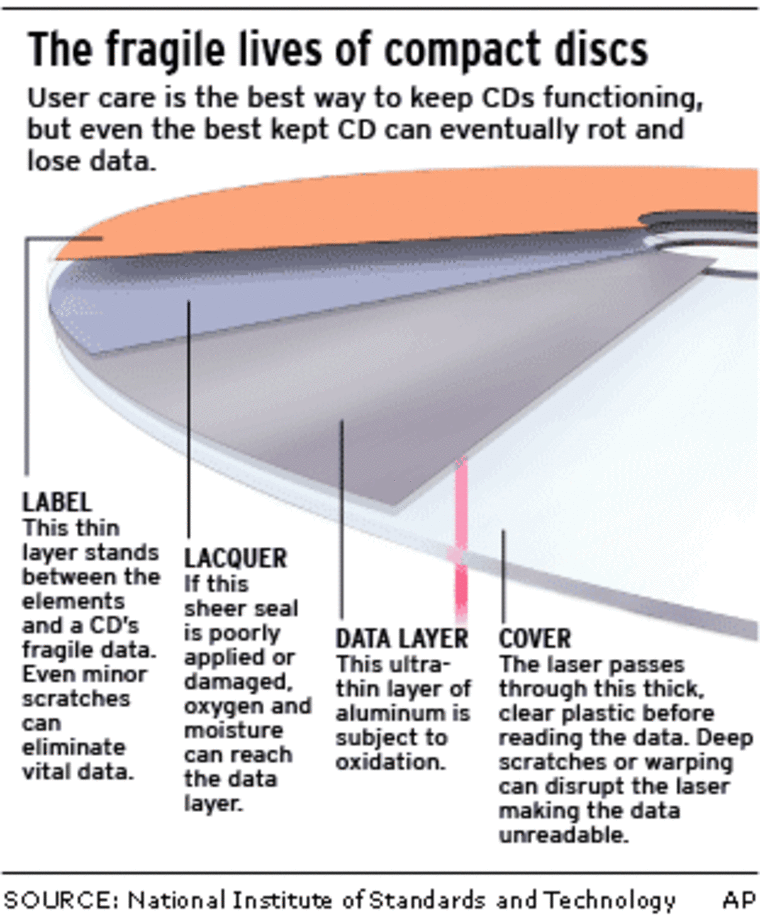Dvd Worn Out From Being Watch Over and Over Again
Dan Koster was unpacking some of his more than ii,000 CDs after a motility when he noticed something foreign. Some of the discs, which he always took expert intendance of, wouldn't play properly.
Koster, a Spider web and graphic designer for Queens University of Charlotte, N.C., took one that was skipping pretty badly and held information technology up to the light.
"I was kind of shocked to encounter a constellation of pinpricks, little points where the light was coming through the aluminum layer," he says.
His collection was suffering from "CD rot," a gradual deterioration of the data-carrying layer. It's not known for sure how common the blight is, simply it'southward just one of a number of reasons that optical discs, including DVDs, may be a lot less long-lived than first thought.
"We were all told that CDs were well-nigh indestructible when they were introduced in the mid '80s," Koster says. "Companies used that in part to justify the higher price of CDs likewise."
He went through his collection and establish that 15 percent to 20 percent of the discs, most of which were produced in the '80s, were "rotted" to some extent.
The rotting tin exist due to poor manufacturing, according to Jerry Hartke, who runs Media Sciences Inc., a Marlborough, Mass., laboratory that tests CDs.

The aluminum layer that reflects the low-cal of the player's laser is separated from the CD label by a sparse layer of lacquer. If the manufacturer applied the lacquer improperly, air tin penetrate to oxidize the aluminum, eating it up much similar iron rusts in air.
But in Hartke's view, it's more mutual that discs are rendered unreadable by poor treatment by the possessor.
"If people care for these discs rather harshly, or stack them, or allow them to rub against each other, this very fragile protective layer can be disturbed, assuasive the atmosphere to interact with that aluminum," he says.
Label side most sensitive, not articulate side
Part of the problem is that most people believe that it's the articulate underside of the CD that is fragile, when in fact it's the side with the characterization. Scratches on the underside have to be fairly deep to cause skipping, while scratches on the top tin easily penetrate to the aluminum layer. Even the pressure of a pen on the label side tin can paring the aluminum, rendering the CD unreadable.
Koster has taken to copying his CDs on his computer to extend the life of the recordings. Unfortunately, it's not easy to effigy out how long those recordable CDs volition piece of work.
Fred Byers, an information technology specialist at the National Institute of Standards and Technology, has looked at writeable CDs on behalf of authorities agencies, including the Library of Congress, that need to know how long their discs will final.
Manufacturers cite lifespans up to 100 years, but without a standardized examination, it's very hard to evaluate their claims, Byers says. The worst role is that manufacturers ofttimes modify the materials and manufacturing methods without notifying users.
"When you lot go to a store and buy a DVD-R, and this goes for CD-R likewise, you actually don't know what you're getting," he says. "If you buy a particular make of disc, and then get the same disc and brand half dozen months later, it can exist very different."
This renders the often heard advice to buy name-make discs for maximum longevity fairly moot, he says.
What to watch out for
DVDs are a chip tougher than CDs in the sense that the data layer (or layers _ some discs accept two) is sandwiched in the middle of the disc betwixt 2 layers of plastic. Only this structure causes problems of its ain, especially in early DVDs. The glue that holds the layers together can lose its grip, making the disc unreadable at least in parts.
Users that bend a DVD to remove information technology from a difficult-gripping case are practically begging for this problem, because flexing the disc puts strain on the glue.
Rewriteable CDs and DVDs, equally opposed to write-one time discs, should not be used for long-term storage because they contain a heat-sensitive layer that decays much faster than the metal layers of other discs.
For maximum longevity, discs should exist stored vertically and only exist handled by the edges. Don't stick labels on them, and in the case of write-once CDs, don't write on them with anything merely soft water-based or alcohol-based markers.
Too, like vino, discs should be stored in a cool, dry identify. Koster's friend Mark Irons, of Corvallis, Ore., stored his CD collection in a cabin heated by a woods-burning stove. The temperature would range betwixt 40 degrees and lxx degrees in the space of a few hours. Now, the data layer of some of his CDs looks as if it's being eaten from the outside.
Irons is notwithstanding pretty happy with CD technology, since it beats vinyl LPs and tape for longevity. At present that he's moved his discs to an flat with a more stable temperature, he'due south noticed that the disuse has slowed.
"I'm hoping they'll agree out till that next medium gets popular, and everyone gets to purchase everything over once again," he says.
kinrosspressita74.blogspot.com
Source: https://www.nbcnews.com/id/wbna4908081